Bristol M.1C
‘Wartime Colours’

Special Hobby, 1/32 scale
S u m m a r y : |
Catalogue Number: |
Special Hobby Kit No.32057 – Bristol M.1C ‘Wartime Colours’ |
Scale: |
1/32 |
Contents & Media |
Approx. 100 grey plastic parts; 1 small sheet of clear acetate; 2 resin parts; 1 fret of photo-etched brass parts, some pre-painted; 1 decal sheet containing markings for 3 aircraft; 12 page full colour instruction booklet |
Price: |
Available online from:
Special Hobby for USD$59.10 plus shipping
Squadron for USD$45.00 plus shipping
Click here for currency conversion. |
Review Type: |
First Look |
Advantages: |
Well-moulded and cast parts; lots of detail; clear instructions; high quality decals. |
Disadvantages: |
Instructions would be easier to read if printed on larger sheets of paper; kit-supplied wing attachment points look suspiciously fragile. |
Conclusions: |
This is a very good kit – it won’t fall together, but with care can be built into a beautiful model. Brass rod will be essential for keeping the wings attached to the fuselage, particularly over time as without support I can’t see the necessarily small wing attachment points being strong enough to stop the wings from drooping, or worse. Careful parts clean up, and lots of test fitting, will be the key to a successful project. Highly recommended to all current and aspiring World War I modellers. |
Reviewed by
Brad Fallen

Special Hobby's 1/32 scale Bristol M.1C is available online from
Squadron.com
The Bristol M.1 was a streamlined monoplane design that first flew in June 1916. Performance was generally excellent but there were some teething problems, and the RFC hierarchy didn’t like the type. Just 125 of the definitive M.1C variant were built, and saw limited frontline service in the Middle East during 1917-18 where they performed well. The M.1C is better known for its postwar use as a trainer and demonstrator, when it was finished in often-flamboyant livery. If you want more information about the Bristol M.1, I thoroughly recommend Colin Ower’s 1991 article entitled “The Bristol M.1 monoplane” which can be easily found online.
For an aircraft produced in such limited numbers, the M.1C has been well represented in kit form. Those of which I am aware (and there may well be more) include:
The Alley Cat product is a clear standout amongst these kits, and received many positive reviews about the quality of its casting, detail and fit. However it is now out of production – partly because Alley Cat’s parent company, A2Zee Models, has been sold and is operating to a different business model, but I suspect mainly because Special Hobby has released a 1/32 M.1C kit in injection-moulded plastic.
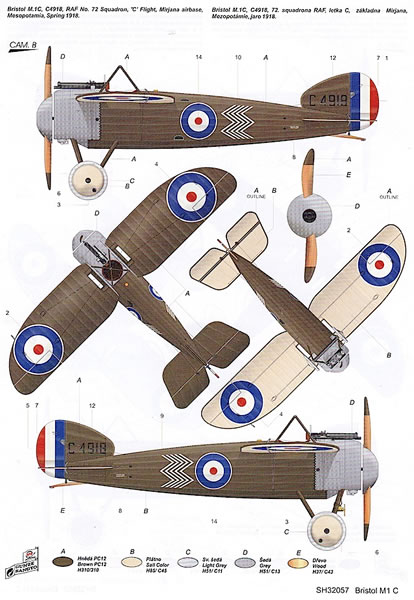
The initial boxing of this kit was entitled “Checkers and Stripes” and, as the title suggests, included markings for three colourful postwar M.1Cs. With care the kit builds into a beautiful model. To see what I mean, have a look at Spencer Pollard’s and Haris Ali’s M.1Cs in the June 2015 edition of Model Airplane International; photos of both models can also be found on Hyperscale’s Plane Talking forum.
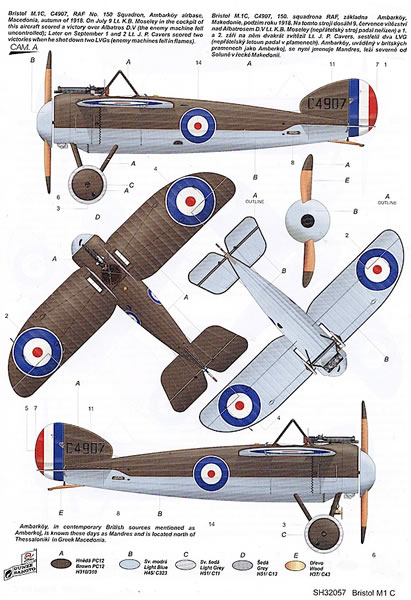
Now Special Hobby has released a second boxing of the kit that focuses on operational M.1Cs, called “Wartime Colours”.
Contents
Special Hobby kits usually have reasonable box art and this one is no exception, showing Bristol M.1C C4907 of No.150 Squadron, RAF (marking option A) strafing a group of Ottoman troops. The box itself is quite small for a 1/32 World War I aircraft – 30 x 19.5cm (12 x 7 ¾ inches) – but this reflects the modest size of the real M.1C. Packed inside are the following items:
A closer look, however, reveals almost flawless moulding and some very fine detail. The fuselage halves feature subtle stitching, fabric and riveted metal effects, and the one-piece wings have well defined (but in my opinion not overdone) rib tapes. I’ve started cleaning up one of the wings and with most of the mould seam lines and sprue attachment nubs removed it is looking very good. The trailing edges could be sharper but are acceptable as is, and the aileron slots neatly into its recess in the wing. (All control surfaces are separate, which is a welcome touch but to avoid accidental damage all should be pinned in place with brass rod – as indeed should the wings themselves.) The two fuselage halves align perfectly despite the absence of locating pins. Of the smaller parts those for the Le Rhone 9J rotary engine are particularly nicely moulded, and a look at Spencer Pollard’s and other online builds shows how well they come together.
One fret of photo-etched brass parts.
Several of these parts – for the seat harness – are pre-painted while the rest are in brass. Most of these are rigging attachment points but windshield frames and cockpit details are also provided.
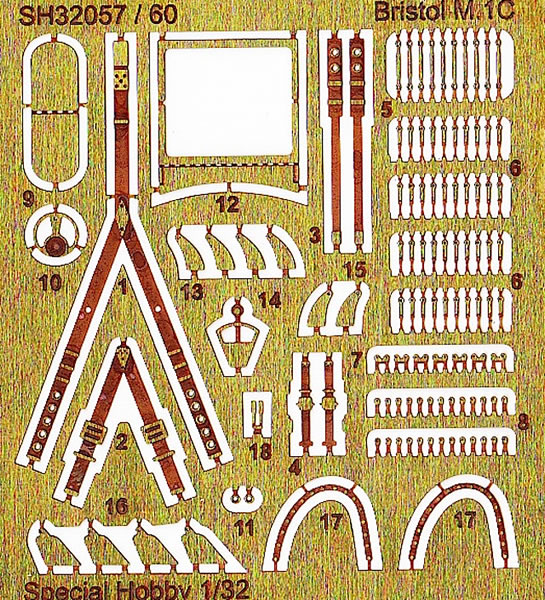
The rigging points are exceptionally small and fragile in appearance, and I’m not sure how long I would persist with them before substituting my favourite eyelets and pre-cut tube from Bob’s Buckles.
Two beautifully cast resin parts.
This is a low resin parts count compared to Special Hobby kits of old, but what parts they are.

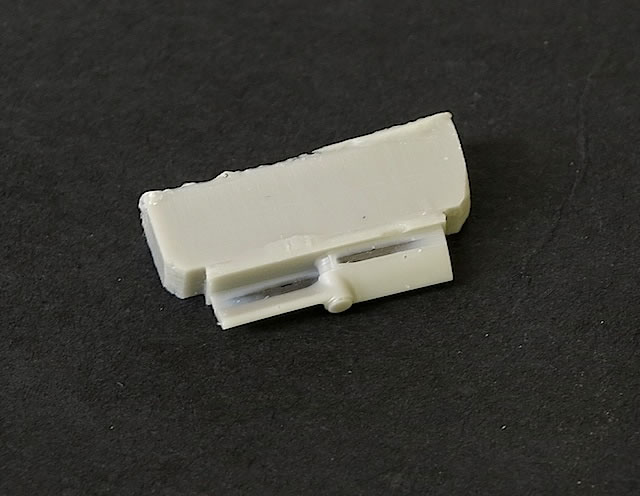

You’ll need a steady hand to cut out your chosen screen without damaging it, but the result will be much thinner (and scale appropriate) than any injection-moulded equivalent.
12 page A5 instruction booklet.
The assembly instructions are clearly set out in logical steps, and make good use of colour to show where everything goes. The only drawback is their size: the 21 x 14cm (8 ¼ x 5 ¾ in) format translates into uncomfortably small and busy illustrations that must be studied carefully to make sure nothing is missed.
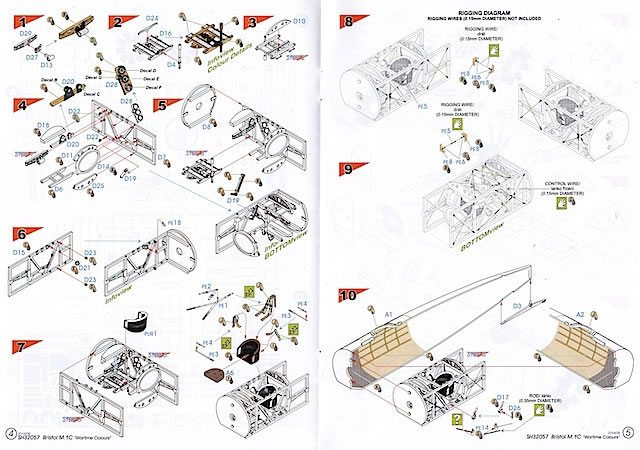
Full colour, four-view painting and marking guides are provided for two of the three aircraft featured. The third is covered in port profile only (it is nominally similar in finish to marking option B) with a promise in the instructions of more information on the company websites. Unfortunately the links provided only brought me to the home pages, and a search of the sites found no further information on option C; hopefully you will have more luck than I did!
One sheet of decals containing markings for three aircraft.
The decal sheet is by Aviprint and looks well done with no obvious registration or other problems. The instrument panel dials and tyre sidewall manufacturer’s details are welcome details.
Marking Options
As I mentioned above, Special Hobby has included markings for three M.1Cs that served with the RAF in the Middle East:
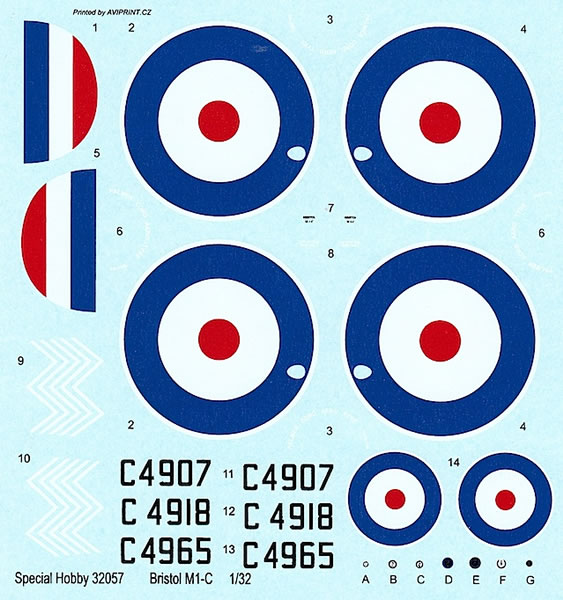
-
C4907 of No.150 Squadron, Ambarkoy, Macedonia in mid-1918. Lts K.B. Moseley and James Pomeroy Cavers scored victories in this machine on 19 July and 1-2 September 1918 respectively. Not mentioned in the instructions, but according to a thread on Britmodeller Cavers’ and C4907’s luck ran out on 3 September 1918 when they were shot down into a lake; Cavers was then strafed to death while swimming to shore. C4907 appears to have been camouflaged in PC 12 over light blue, with a mid-fuselage demarcation between the two colours.
-
C4918 of C Flight, No.72 Squadron, Mirjana, Mesopotamia in spring 1918. I’ve been unable to discover much information on C4918 other than it was finished with a PC 12 fuselage and wing uppers, with the lower wing surfaces in clear doped linen and the engine cowling and spinner in grey. There was a distinctive herringbone pattern on either side of the fuselage behind the national insignia.
-
C4965 – no unit details provided, but reportedly one of a small number of M.1Cs sent to the Western Front and based at Baizieux, France in March 1918. Drawing on the single side profile provided, camouflage and markings seem identical to option B although there are no herringbone patterns on the fuselage sides.
This is a very good kit of an effective, attractive but comparatively little known World War I aircraft. It’s not as refined as the offerings from Wingnut Wings and won’t fall together, but with care can be built into a beautiful model.
Brass rod will be essential for keeping the wings attached to the fuselage, particularly over time as without support from rods I can’t see the necessarily small wing attachment points being strong enough to stop the wings from drooping, or worse.
Careful parts clean up, and lots of test fitting, will be the key to a successful project.
I’ve put this kit close to the top of my build pile, and I’m looking forward to seeing it come together.
Highly recommended to all current and aspiring World War I modellers.
Thanks to MPM/Special Hobby for this review sample.
Review Text Images Copyright © 2015 by Brad Fallen
Page Created 17 September, 2015
Last updated
17 September, 2015
Back to HyperScale Main Page

|
